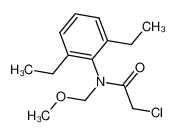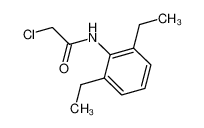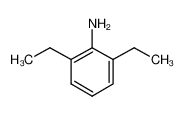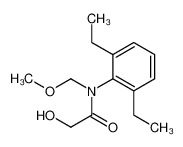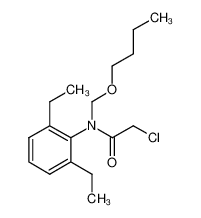1.Identification
1.1 GHS Product identifier
| Product name | Alachlor |
|---|
1.2 Other means of identification
| Product number | - |
|---|---|
| Other names | 2-chloro-N-(2,6-diethylphenyl)-N-(methoxymethyl)acetamide |
1.3 Recommended use of the chemical and restrictions on use
| Identified uses | For industry use only. Herbicide |
|---|---|
| Uses advised against | no data available |
1.4 Supplier's details
| Company | MOLBASE (Shanghai) Biotechnology Co., Ltd. |
|---|---|
| Address | Floor 4 & 5, Building 12, No. 1001 North Qinzhou Road, Xuhui District, Shanghai, China |
| Telephone | +86(21)64956998 |
| Fax | +86(21)54365166 |
1.5 Emergency phone number
| Emergency phone number | +86-400-6021-666 |
|---|---|
| Service hours | Monday to Friday, 9am-5pm (Standard time zone: UTC/GMT +8 hours). |
2.Hazard identification
2.1 Classification of the substance or mixture
Acute toxicity - Oral, Category 4
Skin sensitization, Category 1
Carcinogenicity, Category 2
Hazardous to the aquatic environment, short-term (Acute) - Category Acute 1
Hazardous to the aquatic environment, long-term (Chronic) - Category Chronic 1
2.2 GHS label elements, including precautionary statements
| Pictogram(s) | 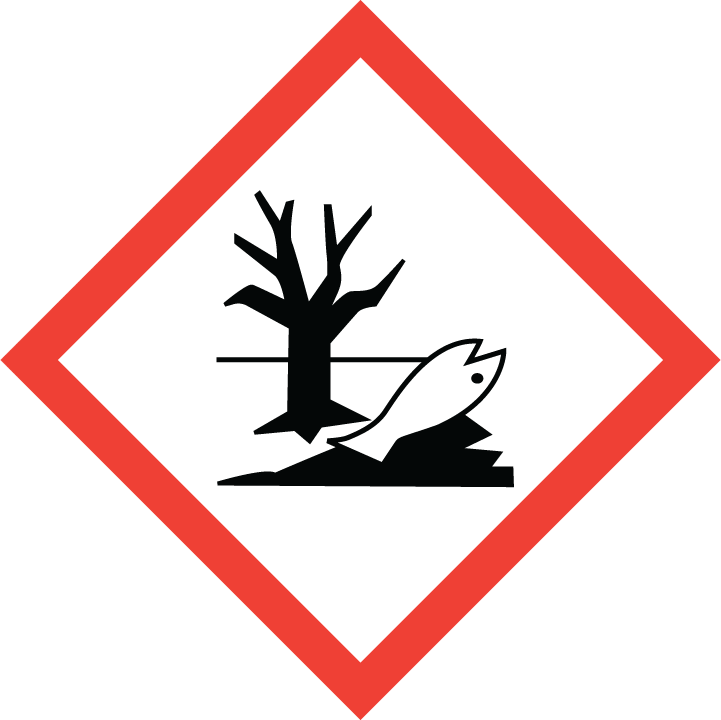   |
|---|---|
| Signal word | Warning |
| Hazard statement(s) | H302 Harmful if swallowed H317 May cause an allergic skin reaction H351 Suspected of causing cancer H410 Very toxic to aquatic life with long lasting effects |
| Precautionary statement(s) | |
| Prevention | P264 Wash ... thoroughly after handling. P270 Do not eat, drink or smoke when using this product. P261 Avoid breathing dust/fume/gas/mist/vapours/spray. P272 Contaminated work clothing should not be allowed out of the workplace. P280 Wear protective gloves/protective clothing/eye protection/face protection. P201 Obtain special instructions before use. P202 Do not handle until all safety precautions have been read and understood. P273 Avoid release to the environment. |
| Response | P301+P312 IF SWALLOWED: Call a POISON CENTER/doctor/…if you feel unwell. P330 Rinse mouth. P302+P352 IF ON SKIN: Wash with plenty of water/... P333+P313 If skin irritation or rash occurs: Get medical advice/attention. P321 Specific treatment (see ... on this label). P362+P364 Take off contaminated clothing and wash it before reuse. P308+P313 IF exposed or concerned: Get medical advice/ attention. P391 Collect spillage. |
| Storage | P405 Store locked up. |
| Disposal | P501 Dispose of contents/container to ... |
2.3 Other hazards which do not result in classification
none
3.Composition/information on ingredients
3.1 Substances
| Chemical name | Common names and synonyms | CAS number | EC number | Concentration |
|---|---|---|---|---|
| Alachlor | Alachlor | 15972-60-8 | none | 100% |
4.First-aid measures
4.1 Description of necessary first-aid measures
General advice
Consult a physician. Show this safety data sheet to the doctor in attendance.
If inhaled
Fresh air, rest. Refer for medical attention.
In case of skin contact
Remove contaminated clothes. Rinse skin with plenty of water or shower.
In case of eye contact
Rinse with plenty of water for several minutes (remove contact lenses if easily possible).
If swallowed
Rinse mouth. Do NOT induce vomiting. Refer for medical attention .
4.2 Most important symptoms/effects, acute and delayed
Excerpt from ERG Guide 151 [Substances - Toxic (Non-combustible)]: Highly toxic, may be fatal if inhaled, swallowed or absorbed through skin. Avoid any skin contact. Effects of contact or inhalation may be delayed. Fire may produce irritating, corrosive and/or toxic gases. Runoff from fire control or dilution water may be corrosive and/or toxic and cause pollution. (ERG, 2016)
4.3 Indication of immediate medical attention and special treatment needed, if necessary
There is no antidote for alachlor. Treatment would be symptomatic.
5.Fire-fighting measures
5.1 Extinguishing media
Suitable extinguishing media
This chemical is not flammable, but may support combustion. Stay upwind of fire. Use dry chemical, carbon dioxide, water spray, or foam extinguishers. Poisonous gases are produced in fire including nitrogen oxides and chlorine. If material or contaminated runoff enters waterways, notify downstream users of potentially contaminated waters. Notify local health and fire officials and pollution control agencies. From a secure, explosion-proof location, use water spray to cool exposed containers. If cooling streams are ineffective (venting sound increases in volume and pitch, tank discolors, or shows any signs of deforming), withdraw immediately to a secure position. If employees are expected to fight fires, they must be trained and equipped in OSHA 1910.156. If employees are expected to fight fires, they must be trained and equipped in OSHA 1910.156.
5.2 Specific hazards arising from the chemical
Excerpt from ERG Guide 151 [Substances - Toxic (Non-combustible)]: Non-combustible, substance itself does not burn but may decompose upon heating to produce corrosive and/or toxic fumes. Containers may explode when heated. Runoff may pollute waterways. (ERG, 2016)
5.3 Special protective actions for fire-fighters
Wear self-contained breathing apparatus for firefighting if necessary.
6.Accidental release measures
6.1 Personal precautions, protective equipment and emergency procedures
Use personal protective equipment. Avoid dust formation. Avoid breathing vapours, mist or gas. Ensure adequate ventilation. Evacuate personnel to safe areas. Avoid breathing dust. For personal protection see section 8.
6.2 Environmental precautions
Personal protection: particulate filter respirator adapted to the airborne concentration of the substance. Do NOT let this chemical enter the environment. Sweep spilled substance into covered containers. Carefully collect remainder. Then store and dispose of according to local regulations.
6.3 Methods and materials for containment and cleaning up
Accidental Release Measures. Personal precautions. Use personal protection recommended /for this product/. Environmental precautions. Minimize spread. Keep out of drains, sewers, ditches and water ways. Notify authorities. Methods for cleaning up. Absorb in earth, sand or absorbent material. Dig up heavily contaminated soil. Collect in containers for reclamation or disposal. ... Wash spill area with detergent and water. Minimize use of water to prevent environmental contamination. /INTRRO/
7.Handling and storage
7.1 Precautions for safe handling
Avoid contact with skin and eyes. Avoid formation of dust and aerosols. Avoid exposure - obtain special instructions before use.Provide appropriate exhaust ventilation at places where dust is formed. For precautions see section 2.2.
7.2 Conditions for safe storage, including any incompatibilities
Provision to contain effluent from fire extinguishing. Separated from strong oxidants and incompatible materials. Keep in a well-ventilated room. Store only in original container. Store in an area without drain or sewer access.Minimum storage temperature: 32 deg F. Incompatible materials for storage: mild steel, PVC. Keep locked up and out of the reach of children. Keep away from living quarters. Keep away from food, drink and animal feed. Keep only in the original container. Keep away from sources of ignition (sparks, flame, etc.). Keep container tightly closed in a cool, well-ventilated place. Protect from frost. ... If frozen, place in warm room and shake frequently to put back into solution. /INTRRO/
8.Exposure controls/personal protection
8.1 Control parameters
Occupational Exposure limit values
no data available
Biological limit values
no data available
8.2 Appropriate engineering controls
Handle in accordance with good industrial hygiene and safety practice. Wash hands before breaks and at the end of workday.
8.3 Individual protection measures, such as personal protective equipment (PPE)
Eye/face protection
Safety glasses with side-shields conforming to EN166. Use equipment for eye protection tested and approved under appropriate government standards such as NIOSH (US) or EN 166(EU).
Skin protection
Wear impervious clothing. The type of protective equipment must be selected according to the concentration and amount of the dangerous substance at the specific workplace. Handle with gloves. Gloves must be inspected prior to use. Use proper glove removal technique(without touching glove's outer surface) to avoid skin contact with this product. Dispose of contaminated gloves after use in accordance with applicable laws and good laboratory practices. Wash and dry hands. The selected protective gloves have to satisfy the specifications of EU Directive 89/686/EEC and the standard EN 374 derived from it.
Respiratory protection
Wear dust mask when handling large quantities.
Thermal hazards
no data available
9.Physical and chemical properties
| Physical state | yellowish crystal |
|---|---|
| Colour | Colorless to white crystalline solid |
| Odour | Odorless |
| Melting point/ freezing point | 39-42ºC |
| Boiling point or initial boiling point and boiling range | 100ºC (0.02 mmHg) |
| Flammability | Combustible. Gives off irritating or toxic fumes (or gases) in a fire. |
| Lower and upper explosion limit / flammability limit | no data available |
| Flash point | -18 °C |
| Auto-ignition temperature | no data available |
| Decomposition temperature | no data available |
| pH | no data available |
| Kinematic viscosity | no data available |
| Solubility | In water:0.024 g/100 mL |
| Partition coefficient n-octanol/water (log value) | log Kow = 3.52 |
| Vapour pressure | 9.74E-07mmHg at 25°C |
| Density and/or relative density | 1.119 g/cm3 |
| Relative vapour density | (air = 1): 9.3 |
| Particle characteristics | no data available |
10.Stability and reactivity
10.1 Reactivity
no data available
10.2 Chemical stability
INDEFINITELY STABLE; NOT SENSITIVE TO LIGHT OR HEAT
10.3 Possibility of hazardous reactions
Dust explosion possible if in powder or granular form, mixed with air.A halogenated acetamide. Organic amides/imides react with azo and diazo compounds to generate toxic gases. Flammable gases are formed by the reaction of organic amides/imides with strong reducing agents. Amides are very weak bases (weaker than water). Imides are less basic yet and in fact react with strong bases to form salts. That is, they can react as acids. Mixing amides with dehydrating agents such as P2O5 or SOCl2 generates the corresponding nitrile. The combustion of these compounds generates mixed oxides of nitrogen (NOx).
10.4 Conditions to avoid
no data available
10.5 Incompatible materials
Strong oxidizers. Corrosive to iron and steel.
10.6 Hazardous decomposition products
When heated to decomposition it emits very toxic fumes of /hydrogen chloride and nitrogen oxides/.
11.Toxicological information
Acute toxicity
- Oral: LD50 Rat oral 790 mg/kg
- Inhalation: LC50 Rat inhalation 1.04 mg/L/4 hrs
- Dermal: no data available
Skin corrosion/irritation
no data available
Serious eye damage/irritation
no data available
Respiratory or skin sensitization
no data available
Germ cell mutagenicity
no data available
Carcinogenicity
Cancer Classification: Likely to be Carcinogenic to Humans (High Doses); Not Likely to be Carcinogenic to Humans (Low Doses)
Reproductive toxicity
no data available
STOT-single exposure
no data available
STOT-repeated exposure
no data available
Aspiration hazard
no data available
12.Ecological information
12.1 Toxicity
- Toxicity to fish: LC50 Lepomis macrochirus (Bluegill sunfish) 2.8 mg/L/96 hr /Conditions of bioassay not specified
- Toxicity to daphnia and other aquatic invertebrates: EC50 Daphnia magna (Water flea) 14 mg/L/24 hr (95% confidence interval: 8.6-19 mg/L); static; Effect: immobilization /Technical grade alachlor 94.64% AI
- Toxicity to algae: EC50 Selenastrum caprincornutum (Algae) 1.9 ug/L/120 hr (95% confidence interval: 1.5-2.4 ug/L); static; Effect: growth inhibition (based on biomass) /Sulfonic acid metabolite of alachlor, 91.5% purity
- Toxicity to microorganisms: no data available
12.2 Persistence and degradability
... SOIL INCUBATION STUDIES SUGGESTS THAT ALACHLOR IS BIODEGRADED RAPIDLY IN SOILS BUT THAT VERY LITTLE RING-LABELED (14)C ALACHLOR IS CONVERTED TO (14)CO2. MAJORITY OF RADIOACTIVITY COULD BE RECOVERED FROM SOIL ONLY AFTER ALKALINE HYDROLYSIS, SUGGESTING THAT HERBICIDAL METABOLITES WERE BOUND TO SOIL ORG MATTER. ... 2-CHLORO-2',6'-DIETHYLACETAMIDE WAS FORMED IN ALACHLOR-TREATED AIR-DRIED SOILS INCUBATED @ 46 DEG C. THIS PRODUCT ... BELIEVED TO RESULT ... FROM ACID-CATALYZED HYDROLYSIS ... ON MINERAL SURFACES.
12.3 Bioaccumulative potential
Biological concentration factors of 2.8 and 10.3 mg/L were measured in fish for alachlor, using bluegill sunfish which were exposed in an ecosystem treated with 2.5 and 10.3 kg/ha, respectively; substantial amounts of residue were present in fish up to 20 days(1). Whole body bioconcentration factor (BCF) for alachlor in fathead minnow (Pimephales promelas) was measured to be 6(2). According to a classification scheme(3), these BCF values suggest the potential for bioconcentration in aquatic organisms is low(SRC). Alachlor was rapidly eliminated upon transfer of fish in uncontaminated water with 81% and 98% being eliminated after 24 hr and 14 days, respectively(2). This rapid elimination was also found in rainbow trout (Salmo gairdneri)(2).
12.4 Mobility in soil
Log Koc values for alachlor have been reported by various authors to range 2.08 (Koc = 120) to 3.33 (Koc = 2,138)(1,2). According to a classification scheme(3), this estimated Koc value suggests that alachlor is expected to have high to low mobility in soil(3). Experimental results confirm that alachlor adsorbs weakly to moderately to soil and the leaching of alachlor from soil is high to medium(4,5). The adsorption of alachlor increases with an increase in organic content, clay content and surface area of soil(4). Alachlor was not detected in groundwater from a soil with high organic and clay content(5). This is probably due to longer residence time in this soil allowing the degradation of alachlor before it reached the water table. The presence of continuous pores or channels in soil will increase the mobility of alachlor in soil(6,7).
12.5 Other adverse effects
no data available
13.Disposal considerations
13.1 Disposal methods
Product
The material can be disposed of by removal to a licensed chemical destruction plant or by controlled incineration with flue gas scrubbing. Do not contaminate water, foodstuffs, feed or seed by storage or disposal. Do not discharge to sewer systems.
Contaminated packaging
Containers can be triply rinsed (or equivalent) and offered for recycling or reconditioning. Alternatively, the packaging can be punctured to make it unusable for other purposes and then be disposed of in a sanitary landfill. Controlled incineration with flue gas scrubbing is possible for combustible packaging materials.
14.Transport information
14.1 UN Number
| ADR/RID: UN3077 | IMDG: UN3077 | IATA: UN3077 |
14.2 UN Proper Shipping Name
| ADR/RID: ENVIRONMENTALLY HAZARDOUS SUBSTANCE, SOLID, N.O.S. |
| IMDG: ENVIRONMENTALLY HAZARDOUS SUBSTANCE, SOLID, N.O.S. |
| IATA: ENVIRONMENTALLY HAZARDOUS SUBSTANCE, SOLID, N.O.S. |
14.3 Transport hazard class(es)
| ADR/RID: 6.1 | IMDG: 6.1 | IATA: 6.1 |
14.4 Packing group, if applicable
| ADR/RID: unknown | IMDG: unknown | IATA: unknown |
14.5 Environmental hazards
| ADR/RID: yes | IMDG: yes | IATA: yes |
14.6 Special precautions for user
no data available
14.7 Transport in bulk according to Annex II of MARPOL 73/78 and the IBC Code
no data available
15.Regulatory information
15.1 Safety, health and environmental regulations specific for the product in question
| Chemical name | Common names and synonyms | CAS number | EC number |
|---|---|---|---|
| Alachlor | Alachlor | 15972-60-8 | none |
| European Inventory of Existing Commercial Chemical Substances (EINECS) | Listed. | ||
| EC Inventory | Listed. | ||
| United States Toxic Substances Control Act (TSCA) Inventory | Not Listed. | ||
| China Catalog of Hazardous chemicals 2015 | Listed. | ||
| New Zealand Inventory of Chemicals (NZIoC) | Listed. | ||
| Philippines Inventory of Chemicals and Chemical Substances (PICCS) | Listed. | ||
| Vietnam National Chemical Inventory | Not Listed. | ||
| Chinese Chemical Inventory of Existing Chemical Substances (China IECSC) | Listed. | ||
16.Other information
Information on revision
| Creation Date | Aug 16, 2017 |
|---|---|
| Revision Date | Aug 16, 2017 |
Abbreviations and acronyms
- CAS: Chemical Abstracts Service
- ADR: European Agreement concerning the International Carriage of Dangerous Goods by Road
- RID: Regulation concerning the International Carriage of Dangerous Goods by Rail
- IMDG: International Maritime Dangerous Goods
- IATA: International Air Transportation Association
- TWA: Time Weighted Average
- STEL: Short term exposure limit
- LC50: Lethal Concentration 50%
- LD50: Lethal Dose 50%
- EC50: Effective Concentration 50%
References
- IPCS - The International Chemical Safety Cards (ICSC), website: http://www.ilo.org/dyn/icsc/showcard.home
- HSDB - Hazardous Substances Data Bank, website: https://toxnet.nlm.nih.gov/newtoxnet/hsdb.htm
- IARC - International Agency for Research on Cancer, website: http://www.iarc.fr/
- eChemPortal - The Global Portal to Information on Chemical Substances by OECD, website: http://www.echemportal.org/echemportal/index?pageID=0&request_locale=en
- CAMEO Chemicals, website: http://cameochemicals.noaa.gov/search/simple
- ChemIDplus, website: http://chem.sis.nlm.nih.gov/chemidplus/chemidlite.jsp
- ERG - Emergency Response Guidebook by U.S. Department of Transportation, website: http://www.phmsa.dot.gov/hazmat/library/erg
- Germany GESTIS-database on hazard substance, website: http://www.dguv.de/ifa/gestis/gestis-stoffdatenbank/index-2.jsp
- ECHA - European Chemicals Agency, website: https://echa.europa.eu/

